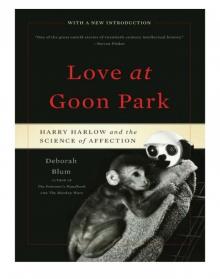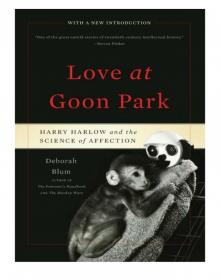- Home
- Deborah Blum
Love at Goon Park: Harry Harlow and the Science of Affection Page 19
Love at Goon Park: Harry Harlow and the Science of Affection Read online
Page 19
Oh, that head was a challenge, too. “First, it had to be designed to be pretty nondestructive,” Zimmermann says. “Monkeys are very destructive creatures. And then it had to have eyes. Mothers have eyes, Harry said. So what are we going to do for eyes? So I go to these dolls’ hospitals and stuff looking for eyes. If you’ve ever seen dolls’ eyes, they’re so fragile. And I said, ‘Well, we need something that’s a little stronger, that can take a knocking around.’
So this woman at the doll store says, ‘Well, they’re pretty expensive.’
I said, ‘Price is no object.’”
Zimmermann is grinning again as he tells this story, blue eyes crinkling at the corners. “So she says, ‘You must work for the state.’”
They kept shopping. They didn’t just want indestructible eyes. They wanted eyes that were also repulsive to monkeys. Harry had warned Schmidt and Zimmermann that the cloth mothers could not have faces that monkeys obviously found attractive. “Because then someone could say, hey, your experiment had nothing to do with touch or being held—it’s just that it’s an attractive stimulus,” Zimmermann says. Critics might dismiss the cuddle effect and argue that the babies liked the way the face looked and that was why they clung to the softer body. “So we started fooling around with different configurations of faces, and then we would see how the monkeys reacted.” They decided on bicycle reflectors for the eyes, which gave the face a bug-like stare. “Those are red bicycle reflectors. The mouth was green plastic, curved in a half moon smile. And the ears were a very hard black plastic that Art Schmidt had hanging around the lab. The nose was maple, painted black.”
Schmidt and Zimmermann had even labored over what kind of wood to use for the heads. They’d tried pinewood balls, but the energetic monkeys chewed the soft wood into splinters. Zimmermann remembers complaining to Harry, “Dr. Harlow, the monkeys are destroying the heads. As fast as we make them, they’re chewing ’em up.”
And he remembers that Harry looked at him, completely deadpan, and replied, “Children have been destroying their parents for years.” The researchers decided to use hardwood for the heads and settled on maple croquet balls, near rock-like in their construction.
Babies do chew on their parents, pull their hair, gnaw on their ears, drool on their shoulders, and throw up all over their shirts. Zimmermann points out that if you watch a baby monkey with its natural mother, the little guy will tug on fur, nibble on ears, yank and pull—all in affection. They’ll do the same thing to a father monkey, given a chance. And this is not destruction at all; it’s curiosity, touch, feel, and the infinite security of being held by someone who will put up with all that tugging and chewing. But monkeys and babies—as Bowlby had been trying to say—indulge in those behaviors only with someone they love and trust.
One of the surrogate mothers in Harry’s lab had a head but no face yet. The head was just a blank ball of wood because Schmidt and Zimmermann had not yet perfected the smiling mother’s face. A baby monkey arrived a month early, so they put the animal in with the faceless cloth mother. “To the baby monkey this featureless face became beautiful and she frequently caressed it with hands and legs,” Harry said. That lasted for about three months. “By the time the baby had reached ninety days, we had constructed an appropriate ornamental cloth-mother face, and we proudly mounted it on the surrogate’s body. The baby took one look and screamed.”
The little monkey huddled in the back of the cage, rocking in dismay. After several days, the infant solved the problem. She marched up and rotated the head 180 degrees so that the blank back of the ball faced forward. The scientists turned it back. She turned it again. They turned it. She turned it. “We could rotate the maternal face dozens of times and within an hour or so, the infant would turn it around 180 degrees.” Within a week, the baby had resolved the problem entirely. She took the head off and rolled it into a corner of the cage and ignored it. And she was willing to repeat this; calmly, Harry said, and with infinite patience. He knew exactly what such behavior represented. Bowlby’s theory predicted that one of the ways a baby bonds to a particular mother comes from its recognition of “the particular mother’s face.” It’s that absolute sureness that this is my mother, that she’s here, that makes everything all right.
The baby doesn’t attach to just anyone, and John Bowlby, Harry Harlow, and a growing army of others were going to make that undeniably clear. There’s an actual relationship here that matters; the baby recognizes this one special person as the one. Later studies at Wisconsin showed that monkeys definitely did not admire the face dreamed up by Zimmermann and built by Schmidt. They preferred a dog’s face to the bug-eyed, green-smiled version of a mother. But for Harry, the antipathy also made a critical point. The infants might not like the mother’s face, he said, but they loved the mother. She could have a blank face, a bug face, any face that they knew well—as long as she had mom’s face. To a baby, mother’s face is always beautiful, he said: “A mother’s face that will stop a clock will not stop a baby.”
The nature of love project was absolutely, beautifully straightforward in making that connection.
Art Schmidt built—as Bill Mason had first proposed—not one but two “surrogate mothers.” The first was a cloth mother. She had that smiling face on a round head and a cylindrical body. The cloth mother was made from a block of wood, covered with sponge rubber, and sheathed in tan cotton terrycloth. A light bulb behind her back radiated heat. You could call her an ideal mother, Harry said, “soft, warm, and tender, a mother with infinite patience, a mother available twenty-four hours a day, a mother that never scolded her infant and never struck or hit her baby in error.” The other mother had a squared, flattish face, two dark holes for eyes, and a frowning mouth. Beneath that scowling visage was another cylindrical body, also warmed by a light bulb, but this time made of wire mesh. It was perfect for climbing, but the wire mother had not a cuddly angle to her. She was metallic all the way through.
Eight baby monkeys went into the first surrogate mother study. Each went into a different cage. In every cage, two mothers awaited the little animal—a cloth mom and a wire mom. Would they prefer her with a warm, soft cloth body or a warm wire one? Oh, but Harry didn’t want a question quite as simple as that. In four of the cages, cloth mom was also equipped to hold a bottle filled with milk. The other four had a “barren” cloth mother; wire mom held the bottle. So the experiment tested the prevailing theories of motherhood on two levels. If infants were indifferent to touch, they might be expected to shift equally between the two mothers. Unless the infant-mother relationship was based on food. If that were so, neither wire mom’s stiff body nor cloth mom’s pillowy one should make a difference. The babies should emphatically prefer the wire mom with the bottle to the cloth alternative. And if they did? Well, that would have been the end of Harry Harlow’s research into the nature of love.
Instead, it was clear to Harry, hell, it was clear to everyone, that being fed formed no relationship at all for these baby monkeys. The mother love study suggested that the wire mother could have been dripping with milk, standing in puddles of the stuff, and yet the little monkeys wouldn’t have cared for her. Cloth mom, on the other hand, was a magnet for a baby monkey.
In the published paper that followed, there are two small, neat, astonishingly clear graphs labeled “Fed on Cloth Mother” and “Fed on Wire Mother.” The graphs track how much time that the baby monkeys spent with each mother in a typical twenty-four-hour period. What makes the charts so remarkable is how alike they are. By the age of six months, both groups are spending pretty much all their time, about eighteen hours a day, with the cloth mom. The wire-fed monkeys hustle back to the wire mother for food, but they eat fast. The charts show that they spend no more than an hour a day on wire mom. Mostly, every one of the baby monkeys are sleeping on cloth mom. Or cuddling. Or tucking their bodies close against her when they are startled. Or just stroking her. The graphs seem to have invisible writing running through them that says food is
sustenance but a good hug is life itself.
Harry knew that he should summarize these results in the psychological jargon of the day. In that famous speech to the APA, he put it like this: “These data make it obvious that contact comfort is a variable of overwhelming importance in the development of affectional responses, whereas lactation is a variable of negligible importance.” Psychology may have been insisting for decades that the baby’s connection to its mother was a limpet-like grip on its source of food, but did psychologists really believe that? Could anyone watch the way an infant burrowed happily into the arms of a parent and believe that it was merely about milk? Or, again, in the lingo of the profession: “This is an inadequate mechanism to account for the persistence of infant-maternal ties.” Really, do you believe that a lifetime bond is built on who holds the bottle? There had been no good experiments to justify that position, Harry argued. And now, when his laboratory had actually done the experiments, he and his students hadn’t found a trace of a bottle-built relationship. They’d found that the baby monkeys—and Harry thought they represented human babies perfectly in this study—responded instead to the reassurance of a gentle touch.
Harry called this “contact comfort.” He meant contact in its most nurturing sense, joyfully skin to skin. Comfort was just another word for security. “One function of the real mother, human or subhuman, and presumably of a mother surrogate, is to provide a haven of safety for the infant in times of fear and danger.” When a child is frightened or sick, it instinctively seeks that haven, he said, and “this selective responsiveness in times of distress, disturbance or danger may be used as a measure of the strength” of the emotional connection. This again was an idea very close to John Bowlby’s notion that a parent provides a secure base for a child. Harry and his students decided to pursue that connection further, to see whether they could better define the way a parent makes a child feel safe. What does it take to provide a safe harbor?
“We started asking simple questions,” says Bob Zimmermann. “What does a baby do? How does a baby react in relation to his mother?” They were already beginning to appreciate just how intensely the small animals attached to the green-smiling surrogates. The surrogates were wrapped in a cloth “smock” that was changed every day for hygiene reasons. When the surrogates needed to be cleaned, a door came down between the baby monkeys and their mothers. The lab crew would then provide the clean clothes. Meanwhile, the little monkeys wailed in dismay, pressed against the door, paced the cage looking for her. When the door came up again, the babies would plaster themselves against cloth mom, grasping onto her smock like a lifeline.
“So when he’s frightened, does he look to his mother?” Zimmermann asks. Does he hold on with that same desperate “save me from the world” intensity? By now, Harry’s graduate students were fully engaged in the research. They bought a little toy bear that marched and banged a small metal drum and a toy dog that barked—“Arf, arf, arf,” Zimmermann demonstrates. The point of these jerky, strange, noisy creatures was that they would trigger a fear response in the little monkeys. The researchers would put the toy in a box, roll it up next to a cage where a baby monkey was housed with a cloth mom, open the box, and start the bear banging the drum.
“These monkeys were only five days old, they could hardly walk, but some of them in sheer fear would just fly across the space to the mother,” says Zimmermann, his hands making a graceful arc in the air, replicating the airborne lift of baby to mother. “By the time they were just a few weeks old, say thirty days, when they could really get their feet under them, everybody was running to the cloth mother,” clinging with both hands, burrowing their faces into that warm fluffy body, closing their eyes. Pretty soon, the cloth mother was simply base camp. The little monkeys slept on her. A young animal might leave and explore a little, but he’d always hurry back. Even while venturing around the cage, he’d check over his shoulder to make sure that she was still there, watching over him.
The scientists now had twelve monkeys in the study. Zimmermann and Lorna Smith were testing the infants four to five times a day. The lab crew was putting together a picture based on Harry’s favorite kind of statistics—small, tight, personal, real. “There were some people very critical of the surrogate work because of the statistics,” Zimmermann says. Critics complained that the study lacked large cohorts of animals and the statistical depth that comes with a big population. “And my answer to them was—the study didn’t need elaborate statistics. It just made sense.”
The effects were so strong, the connection between baby and surrogate so visible, that the scientists began to wonder about other ways to test that bond and the security that seemed to come with it.
Bill Mason had taken a pocket of a room in the lab, six feet by six feet, and created a play space for the monkeys. He called it an “open field.” Mason saw the field as a space where monkeys could be challenged beyond the WGTA’s ordered trays. He wanted to use puzzles and locks and toys to study curiosity and he wanted to give the monkeys room to explore. Bob Zimmermann started thinking about the space itself. What if the open field could be made into a strange little world, a place somehow scary to a baby monkey?
Zimmermann had read a 1943 paper by a Gestalt psychologist, Jean Arsenian, who had conducted an experiment with children in a playroom. Arsenian had spent hours observing toddlers when their mothers were in the room, watching how they played or simply fell still when their mothers left. “And she talked about the mother having a field of influence,” Zimmermann says, and that field was like a charmed circle in which the baby could safely and happily play. If a child felt secure, it was as if she carried that charm with her so that she could wander freely away more easily than a less secure toddler. The playroom was a powerful way of demonstrating the mother’s field of influence, Zimmermann thought. So what if they took the open field and they used it like an Arsenian playroom—would cloth mom also have a zone of influence, generate a charmed circle of safety?
By the time Harry gave his presidential talk to the American Psychological Association in September 1958, he and his students had been testing four of their surrogate-raised mothers twice a week for two months in the open-field test. Zimmermann’s question seemed a charmed prediction. In the open-field room, the little monkeys rushed to the cloth mother, clutched her, rubbed her, and cuddled. The first few times the monkeys were in the room, they never once let cloth mom go, just held tight and barely looked up. But after a while, as long as she was there, the little animals would look around the space. They would begin to get interested. The youngsters might climb a little, push a puzzle piece around, go back to mom, wander out for a while, return to mom, chew on a toy, return to mom. Without her, though—if the scientists decided to keep cloth mom out of the room—literally, the infants were lost. They would screech, crouch, rock, suck their hands. “Baby monkeys would rush to the center of the room where the mother was customarily placed, looking for her, and then run rapidly from object to object, screaming and crying all the while,” Harry said.
Wire mom was almost as hopeless as no mom. The wire mother could sit in the open-field room all day, but she had nothing to give in terms of reassurance. She was just one more unnerving object. The baby monkeys who went into the field with a wire mother, even those who were accustomed to being fed by her, looked like abandoned children. They were terrified out there in the strange little world of the open field. Even with wire mom sitting squarely and obviously in the middle of the room, they would turn instead to the wall, huddling in its shelter.
As it turned out, the behavior of the little monkeys in Harry’s lab fit almost exactly with some inspired studies done by a young supporter of John Bowlby’s, an Ohio-born psychologist named Mary Salter Ainsworth. Ainsworth had earned her degree at the University of Toronto. She trained under a scientist there, William Blatz, who was trying to make everyone, anyone, including his students, listen to his “security” theory, which argued, in part, that a child derives security from b
eing near his parents. That sense of safety, Blatz argued, enables the child to go out and explore the world.
Ainsworth, who always described herself as rooted in insecurity, liked the theory so much that she focused her Ph.D. dissertation around it. In 1950, serendipity brought her and Bowlby together. Her husband got a job in England. She went with him and began job-hunting. Bowlby, by that time, was advertising in the newspapers for help and Ainsworth answered his ad. She spent more than three years working with Bowlby, James Robertson, the researcher who had filmed hospitalized children, and the new and precarious attachment team before again following her husband, this time to Uganda, where he had taken a teaching position.
Determined yet to do something with her psychology training, Ainsworth began spending time in the tribal villages, at first just watching. For all her time with Bowlby, she still thought that the Freudians might be right, that a baby merely bonded to the person who fed him, reinforced, as it were, by being fed. But in the Ganda village, she watched children and their mothers and she changed her mind. The relationship was absolutely specific. “The mother picked up the baby, the baby would stop crying, but if somebody else tried to pick him up at that point, he would continue to cry,” Ainsworth said. The villagers might even share feeding duties, rocking duties, but, in the end, neither milk nor bed created the same bond. A child always knew mother from other.
Babies smiled differently for their mothers; their faces lit in a way that they didn’t for strangers. They cooed and coaxed differently. If a mother walked out of the room, her baby would crawl after her. If she came into a room, baby scuttled joyfully in her direction. One of the central points in Bowlby’s theory is that attachment involves a precise relationship—and an interactive one. The mother responds to the baby and the baby does her best to keep the mother doing that. She wants her mother close. Therefore, the infant works to bind and attach her mother. In return for all that effort, the baby is rewarded with security. A smile is a wonderful example, then, of a baby’s pulling his mother in just a little tighter. “Can we doubt that the more and better an infant smiles the better he is loved and cared for?” Bowlby liked to say.

 Love at Goon Park: Harry Harlow and the Science of Affection
Love at Goon Park: Harry Harlow and the Science of Affection The Poison Squad
The Poison Squad Ghost Hunters: The Victorians and the Hunt for Proof of Life After Death
Ghost Hunters: The Victorians and the Hunt for Proof of Life After Death The Poisoner's Handbook
The Poisoner's Handbook Angel Killer
Angel Killer The Best American Science and Nature Writing 2014
The Best American Science and Nature Writing 2014 The Ghost Hunters
The Ghost Hunters Love at Goon Park
Love at Goon Park